Intel Core i7-10700 vs Core i7-10700K Review: Is 65W Comet Lake an Option?
by Dr. Ian Cutress on January 21, 2021 10:30 AM EST- Posted in
- CPUs
- Intel
- Core i7
- Z490
- 10th Gen Core
- Comet Lake
- i7-10700K
- i7-10700
CPU Tests: Rendering
Rendering tests, compared to others, are often a little more simple to digest and automate. All the tests put out some sort of score or time, usually in an obtainable way that makes it fairly easy to extract. These tests are some of the most strenuous in our list, due to the highly threaded nature of rendering and ray-tracing, and can draw a lot of power. If a system is not properly configured to deal with the thermal requirements of the processor, the rendering benchmarks is where it would show most easily as the frequency drops over a sustained period of time. Most benchmarks in this case are re-run several times, and the key to this is having an appropriate idle/wait time between benchmarks to allow for temperatures to normalize from the last test.
Blender 2.83 LTS: Link
One of the popular tools for rendering is Blender, with it being a public open source project that anyone in the animation industry can get involved in. This extends to conferences, use in films and VR, with a dedicated Blender Institute, and everything you might expect from a professional software package (except perhaps a professional grade support package). With it being open-source, studios can customize it in as many ways as they need to get the results they require. It ends up being a big optimization target for both Intel and AMD in this regard.
For benchmarking purposes, we fell back to one rendering a frame from a detailed project. Most reviews, as we have done in the past, focus on one of the classic Blender renders, known as BMW_27. It can take anywhere from a few minutes to almost an hour on a regular system. However now that Blender has moved onto a Long Term Support model (LTS) with the latest 2.83 release, we decided to go for something different.
We use this scene, called PartyTug at 6AM by Ian Hubert, which is the official image of Blender 2.83. It is 44.3 MB in size, and uses some of the more modern compute properties of Blender. As it is more complex than the BMW scene, but uses different aspects of the compute model, time to process is roughly similar to before. We loop the scene for at least 10 minutes, taking the average time of the completions taken. Blender offers a command-line tool for batch commands, and we redirect the output into a text file.

The 10700K takes a small lead.
Corona 1.3: Link
Corona is billed as a popular high-performance photorealistic rendering engine for 3ds Max, with development for Cinema 4D support as well. In order to promote the software, the developers produced a downloadable benchmark on the 1.3 version of the software, with a ray-traced scene involving a military vehicle and a lot of foliage. The software does multiple passes, calculating the scene, geometry, preconditioning and rendering, with performance measured in the time to finish the benchmark (the official metric used on their website) or in rays per second (the metric we use to offer a more linear scale).
The standard benchmark provided by Corona is interface driven: the scene is calculated and displayed in front of the user, with the ability to upload the result to their online database. We got in contact with the developers, who provided us with a non-interface version that allowed for command-line entry and retrieval of the results very easily. We loop around the benchmark five times, waiting 60 seconds between each, and taking an overall average. The time to run this benchmark can be around 10 minutes on a Core i9, up to over an hour on a quad-core 2014 AMD processor or dual-core Pentium.
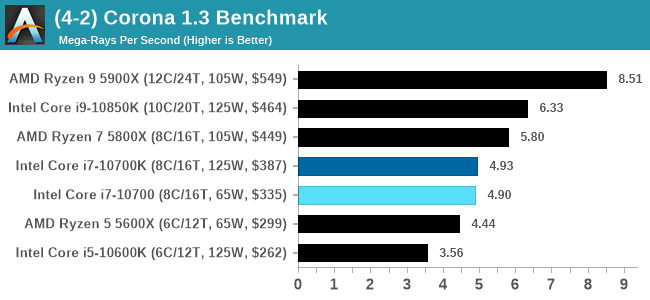
The 10700K takes a small lead.
Crysis CPU-Only Gameplay
One of the most oft used memes in computer gaming is ‘Can It Run Crysis?’. The original 2007 game, built in the Crytek engine by Crytek, was heralded as a computationally complex title for the hardware at the time and several years after, suggesting that a user needed graphics hardware from the future in order to run it. Fast forward over a decade, and the game runs fairly easily on modern GPUs.
But can we also apply the same concept to pure CPU rendering? Can a CPU, on its own, render Crysis? Since 64 core processors entered the market, one can dream. So we built a benchmark to see whether the hardware can.
For this test, we’re running Crysis’ own GPU benchmark, but in CPU render mode. This is a 2000 frame test, with medium and low settings.
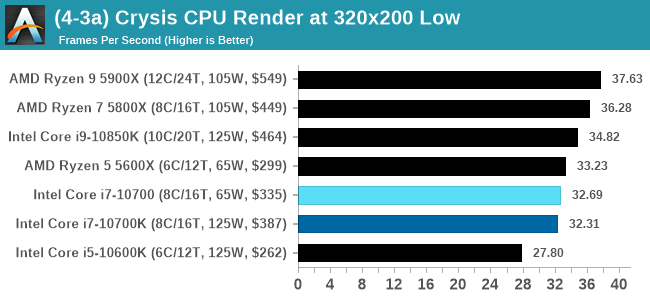
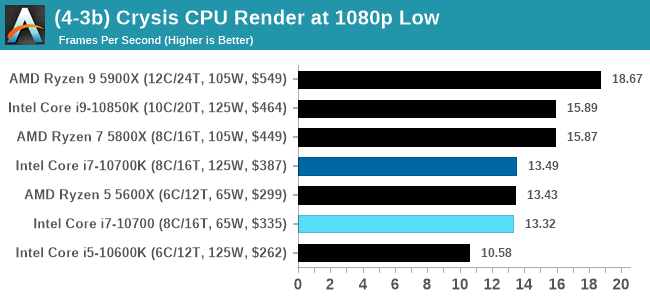
Almost playable.
POV-Ray 3.7.1: Link
A long time benchmark staple, POV-Ray is another rendering program that is well known to load up every single thread in a system, regardless of cache and memory levels. After a long period of POV-Ray 3.7 being the latest official release, when AMD launched Ryzen the POV-Ray codebase suddenly saw a range of activity from both AMD and Intel, knowing that the software (with the built-in benchmark) would be an optimization tool for the hardware.
We had to stick a flag in the sand when it came to selecting the version that was fair to both AMD and Intel, and still relevant to end-users. Version 3.7.1 fixes a significant bug in the early 2017 code that was advised against in both Intel and AMD manuals regarding to write-after-read, leading to a nice performance boost.
The benchmark can take over 20 minutes on a slow system with few cores, or around a minute or two on a fast system, or seconds with a dual high-core count EPYC. Because POV-Ray draws a large amount of power and current, it is important to make sure the cooling is sufficient here and the system stays in its high-power state. Using a motherboard with a poor power-delivery and low airflow could create an issue that won’t be obvious in some CPU positioning if the power limit only causes a 100 MHz drop as it changes P-states.

V-Ray: Link
We have a couple of renderers and ray tracers in our suite already, however V-Ray’s benchmark came through for a requested benchmark enough for us to roll it into our suite. Built by ChaosGroup, V-Ray is a 3D rendering package compatible with a number of popular commercial imaging applications, such as 3ds Max, Maya, Undreal, Cinema 4D, and Blender.
We run the standard standalone benchmark application, but in an automated fashion to pull out the result in the form of kilosamples/second. We run the test six times and take an average of the valid results.
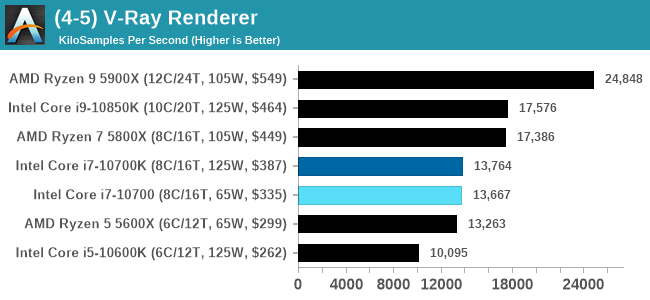
Cinebench R20: Link
Another common stable of a benchmark suite is Cinebench. Based on Cinema4D, Cinebench is a purpose built benchmark machine that renders a scene with both single and multi-threaded options. The scene is identical in both cases. The R20 version means that it targets Cinema 4D R20, a slightly older version of the software which is currently on version R21. Cinebench R20 was launched given that the R15 version had been out a long time, and despite the difference between the benchmark and the latest version of the software on which it is based, Cinebench results are often quoted a lot in marketing materials.
Results for Cinebench R20 are not comparable to R15 or older, because both the scene being used is different, but also the updates in the code bath. The results are output as a score from the software, which is directly proportional to the time taken. Using the benchmark flags for single CPU and multi-CPU workloads, we run the software from the command line which opens the test, runs it, and dumps the result into the console which is redirected to a text file. The test is repeated for a minimum of 10 minutes for both ST and MT, and then the runs averaged.

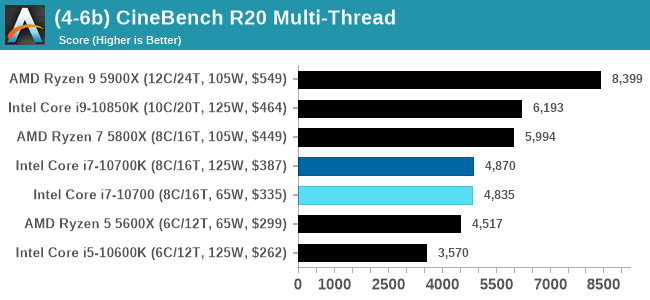
We are still in the process of rolling out CineBench R23 (you can see the results in our benchmark database here), but had not tested it on all the CPUs in this review at this time. It will be added to future reviews.
















210 Comments
View All Comments
dullard - Thursday, January 21, 2021 - link
Yes, it is sad that even well respected PhDs in the field can't seem to understand that TDP is not total consumed power. Never has been, never will be. TDP is simply the minimum power to design your cooling system around.I actually think that Intel went in the right direction with Tiger Lake. It will do everyone a service to drop any mention of TDP solely into the fine print of tech documents because so many people misunderstand it.
Yes, TSMC has a fantastic node right now with lower power that AMD is making good use of. Yes, that makes Intel look bad. Lets clearly state that fact and move on.
Power usage matters for mobile (battery life), servers (cooling requirements and energy costs), and the mining fad (profits). Power usage does not matter to most desktop users.
dullard - Thursday, January 21, 2021 - link
Also don't forget that we are talking about 12 seconds or 28 seconds of more power, then it drops back down unless the motherboard manufacturer overrides it. The costs to desktop users for those few seconds is fractions of a penny.bji - Thursday, January 21, 2021 - link
"minimum power to design your cooling system around" makes NO SENSE.You don't design any cooling system to handle the "minimum", you design it to handle the "maximum".
It sounds like you've bought into Intel's convoluted logic for justifying their meaningless TDP ratings?
iphonebestgamephone - Thursday, January 21, 2021 - link
Why are there low end and high end coolers then? Arent the cheap ones for the minimum, in this case 65w?Spunjji - Friday, January 22, 2021 - link
dullard's comments are, indeed, a post-hoc justification in search of an audience.dullard - Friday, January 22, 2021 - link
Bji, no, that is not how how engineering works. You need to know the failure limit on the minimum side. If your cooling system cannot consistently cool at least 65W, then your product will fail to meet specifications. That is a very important number for a system designer. Make a 60W cooling system around the 10700 chip and you'll have a disaster.You can always cool more than 65W and have more and/or faster turbos. There is no upper limit to how much cooling capability you can use. A 65W cooler will work, a 125W cooler will work, a 5000 W cooler will work. All you get with better cooling is more turbo, more often. That is a selling point, but that is it - a selling point. It is the the 65W number that is the critical design requirement to avoid failures.
edzieba - Friday, January 22, 2021 - link
Minor correction on " Never has been, never will be": TDP and peak package power draw WERE synonymous once, for consumer CPUs, back when a CPU just ran at a single fixed frequency all the time. It's not been true for a very long time, but now persists as a 'widely believed fact'.Something being true only in very specific scenarios but being applied generally out of ignorance is pretty common in the 'enthusiast' world: RAM heatsinks (if you're not running DDR2 FBDIMMs they're purely decorative), m.2 heatsinks (cooling the NAND dies is actively harmful, cooling the controller was only necessary for a single model of OEM-only brown-box Samsung drives because nobody had the tool to tell the controller to not run at max power all the time), hugely oversized WC radiators (from the days when rad area was calculated assuming repurposed low-density-high-flow car AC radiators, not current high-density-low-flow radiators), etc.
Even now "more cores = more better" in the consumer market, despite very few consumer-facing workloads spanning more than a handful of threads (and rarely maxing out more than a single core).
dullard - Friday, January 22, 2021 - link
I'll give you credit there. I should have said "not since turbo" instead of "never has been". Good catch. I wish there was an edit button.Spunjji - Friday, January 22, 2021 - link
What's really sad is that you apparently prefer to write a long comment trying to dunk on the author, rather than read the article he wrote for you to enjoy *for free*."I actually think that Intel went in the right direction with Tiger Lake"
You think poorly.
"Yes, TSMC has a fantastic node right now with lower power that AMD is making good use of. Yes, that makes Intel look bad. Lets clearly state that fact and move on."
Aaaand there's the motivation for the sour grapes.
dullard - Friday, January 22, 2021 - link
Spunjji, I must assume since you didn't have anything to actually refute what I said, that you have nothing to refute it and instead choose to bash the messenger. Thanks for backing me up!